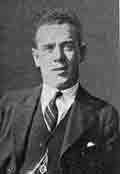Railway Tavern.
520 Rutherglen Road, Gorbals, Glasgow.
International footballer fae the Gorbals.
Jimmy Howieson was a sportsman an International footballer, who had been in the licensed trade all his life. Many of his fans thought that Jimmy Howieson entered the trade after his playing days were over.
James Howieson was born in 1900 in the Gorbals and had three sisters and two brothers all of whom had worked in their father’s pub in Queen Street especially during the summer holidays.
James followed in his father’s footsteps an owned the Railway Tavern at 520 Rutherglen Road not far from his place of birth, his father John owned the Crammond Bar, 157 Queen Street for thirty five years a licence which was taken over by Mrs Howieson when her husband died.

Jimmy Howieson.
Jimmy was educated at Rutherglen Elementary School and John Street School. Strange to say, he was not one of those boy football fanatics who had carved themselves a niche in the hall of soccer fame.
After school, James worked with his father in the pub before embarking on a career as a marine engineer. That was when he started out to be, and he served two years of his time before an accident and a few smashed fingers led his feet, very literally, in another direction.
This happened near the end of 1917 and the day he was discharged from hospital found him making tracks for the nearest Navy recruiting office. He signed on to serve twenty five years with the Senior Service. In his youth, like other lads of his age, he used to kick a ball up and down Rutherglen Road and in the parks, but he never played football in a recognised team, school or otherwise, until he joined the Navy. In fact, he had little time to play, because when he was at home he was either at work or giving his father a hand in the Crammond Bar.
By the way, the Crammond Bar was named after his fathers favourite place near Edinburgh the Crammond Village.
In the Navy, playing football for the ship’s team, he played against all nationalities, and in all climates. Matches were played at Cape Town, the West Indies, Spain and whatever port of call they weighed anchor. The football of those days was on the he-man variety, and made Jimmy as tough as they make them.
Came 1921, and while he was on shore leave he received permission from the skipper to play football at home. He played a few games for junior combines, Port Glasgow being his first team, and he played along with a companion from the ship called Duffy, who was an all round athlete.
Of the two, Howieson was the one who found the game most attractive, and with a sum close on £50 he bought his discharge from the Navy and settled down to be a footballer.
He played for Rutherglen Glencairn until the end of the season and then signed for Airdrieonians. In the following year the Lanarkshire team won the Scottish Cup and Jimmy secured his first cup medal. At the end of that season he joined the ranks of St Johnstone at Muirton Park, Perth and then began a series of exchanges which amazed the football world.
He played for St. Johnstone in their League games and for St. Mirren in their cup ties: All this in the same season and it was affected by transferring him backwards and forwards as if he were a shuttle-cock. That is something that cannot happen today, with the S. F. A.’s rulings on the subject, but it gave Jimmy Howieson both travelling and experience of the world.
At the end of the season, instead of going to St. Mirren as everyone had thought would have happened, he signed up for Dundee United, but his career with them was a short one and mid-way through the next season he was on the Paisley eleven’s books. Fate must have prompted that signing, for by the last day of the 1926-27 fixture list, Jimmy had secured a second Scottish Cup Medal.
St. Mirren for the first time in their career won the cup, beating Celtic in a memorable final 2-0, and it was Jimmy Howieson who clinched matters with a second goal. The same year he received his cap against Ireland and at the end of the season Hull City tabled £3200 for his transfer. St. Mirren accepted, and Howieson went through to England for his first taste of football over the Scottish borders.
He just couldn’t settle there, however, and was badly off form, and eventually turned down the retaining fee offer that made him and packed his grip for the United States of American.
He played for New Bedford and New York Giants and found himself back in the old Navy style of game. The money was good, however, despite the fact that the gate was small. The prices charged for admission in those days were something like a dollar and a quarter (five shillings or more).
A cable from Hull City offering new terms brought him back to British soil and he joined their forward line once more. That year Hull City went to the semi-final of the English Cup and Jimmy almost had an English Cup medal to add to his Scottish pair. Hull City was leading 2-0 with about fifteen minutes to go, when, after a change in their formation, Arsenal drew level. They won the re-play and went on to win the cup.
That match, says Jimmy, was by far the most exciting of his whole career, beating the Celtic-St. Mirren final easily for the position.
Placed on Hull City’s open to transfer list at the same price at which they paid for him £3200, Jimmy went to Ireland and played there for two years with Shelbourne and they won the Free State League and the Leinster Shield while he associated with them. When he left Irish football he joined Clyde, a football team which he had supported as a youth, and for whom he still had a soft spot for until he died. Two years service with them and back to Ireland again. This time he hung his boots in the Glenavon locker and then shifted them to Belfast Celtic’s pavilion, just a month before his brother and himself took over the Railway Tavern. For several years Jimmy had been on the look-out for such a pub and when the opportunity came he took it. And so many fans frequented his new pub in the hope of getting an autograph and a chat about his football career.
Do you remember Jimmy’s pub the Railway Tavern or one of his father’s pubs? If so please get in touch. One of the last licensee for the Railway Tavern was a lady called Margaret Bogle.
End.
